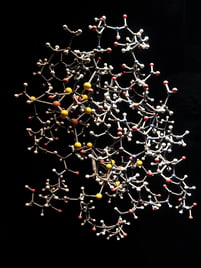
The use of peptides for the generation of antibodies against specific peptides has become an essential tool in proteomic research. However, while they are designed to be good epitopes by themselves, these immunogenic peptides or haptens are too small (size ranges from 1000-2000 Daltons) to elicit a strong antibody response, even when emulsified in an appropriate adjuvant.
Basically, if you want to promote a good immune response, your antigen should have at least two different "epitopes" - one to stimulate the T cells, and another to interact with the B cells. Since the haptens are too small, they simply cannot contain two clear epitopes.
To address this issue, they are usually coupled with a larger carrier protein molecule (size >60kDa) which provides the additional motifs required to associate with class II molecules and T-cell receptors. Once this requirement is met, the immunogenic peptides will then have the ability to generate a stronger antibody response. Some of the most common carrier proteins used for this purpose are Keyhole Limpet Hemocyanin (KLH), Bovine Serum Albumin (BSA) and cationized BSA.
Coupling the Peptide to a Carrier Protein
There are a number of approaches that can be used for conjugating haptens to carrier proteins. The choice of which depends on the following factors:
- The functional groups available on the hapten;
- The required hapten orientation and distance from the carrier;
- The possible effect of conjugation on biological and antigenic properties.
Haptens can be coupled to a carrier protein using the following methods – EDC conjugation, maleimide conjugation and glutaraldehyde conjugation.
EDC conjugation (carboxyl and amine crosslinking)
This is the simplest and most effective method for protein-carrier and peptide-carrier conjugations. EDC reacts with available carboxyl groups on either the protein carrier or peptide hapten to form an active o-acylisourea intermediate which then reacts with a primary amine to form an amide bond and a soluble urea by-product. This reaction can produce a conjugated immunogen in less than two hours.
Note: EDC conjugations usually result in a certain amount of polymerization which may actually enhance the immunogenicity of the peptide and produce a greater antibody response.
Maleimide conjugation (sulfhydryl crosslinking)
In maleimide conjugation, the carrier protein is activated by reacting it with a molar excess of Sulfo-SMCC (sulfosuccinimidyl 4-(N-maleimidomethyl)cyclohexane-1-carboxylate). SMCC molecules will attach to the carrier protein as the abundant amino group of the carrier protein displaces the NHS-ester group. (Note: Other crosslinkers such as Sulfo-EMCS or Sulfo-GMBS may also be used.)
The solution is incubated for 60 minutes at room temperature or 30 minutes at 37oC with periodic gentle mixing. The modified carrier protein is then purified by gel filtration (desalting) to remove any excess crosslinker and resulting by-products. The purified carrier now possesses modifications generated by the crosslinker, producing a number of reactive maleimide groups projecting from its surface.
To facilitate hapten conjugation, add cysteine-terminated peptide or other sulfhydryl hapten to the maleimide-activated carrier protein, and let it stand for two hours at room temperature. The maleimide groups will react with the peptide sulfhydryl (–SH) groups to form stable thioether bonds. You can then purify the conjugate by desalting or dialysis to remove EDTA and sodium azide.
Additional Notes:
- DMSO may be used for solubilization for haptens with limited solubility. However, since dialysis is not compatible with DMSO, you should add DMSO to the Purification Buffer Salts for desalting to prevent precipitation in the column.
- If a precipitate formed during conjugation, centrifuge the material, collect the supernatant and save the precipitate. Use the supernatant for purification and add the purified conjugate to the precipitate.
Image options: Flesh for Blood






